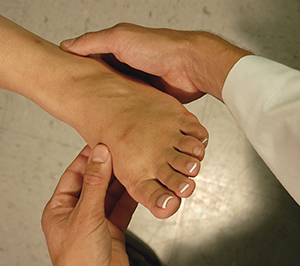Diabetes: Keeping Feet Healthy
Diabetes: Keeping Feet Healthy

Take special care
Here are tips for taking special care of your feet:
Inspect your feet daily for problems such as redness, blisters, cracks, dry skin, or numbness. Use a mirror to see the bottoms of your feet. Or, ask for help.
Manage your diabetes. Monitor and control your blood sugar. Take all your medicines as prescribed.
Avoid walking barefoot, even indoors. Always wear socks inside your shoes.
Wash your feet with warm water and mild soap. Dry well, especially between toes.
Don’t treat corns or calluses yourself. Talk to your healthcare provider or podiatrist (a healthcare provider who specializes in foot care) if you need assistance trimming your toenails.
Use moisturizing cream or lotion if you have dry skin, but don’t use it between toes.
Don’t use heating pads on your feet. If you have neuropathy, you could get a burn and not feel it.
Stop smoking. Smoking restricts blood flow and can make it harder for wounds to heal.
Don't use sharp blades to trim your nails. Use a nail clipper and file instead.
Have regular checkups
Foot problems can develop quickly. So be sure to follow your healthcare team’s schedule for regular checkups. During office visits, take off your shoes and socks as soon as you get in the exam room. Ask your healthcare provider to examine your feet for problems. This will make it easier to find and treat small skin irritations before they get worse. Regular checkups can also help keep track of the blood flow and feeling in your feet. If you have neuropathy, you may need to have checkups more often.
Wear proper footwear
Wearing proper footwear is very important. If areas of your feet have been damaged by too much pressure, your healthcare provider may recommend changing your footwear. In some cases, avoiding high heels or tight work boots may be all that’s needed. Or, your healthcare provider may recommend special shoes or custom inserts. These help protect your feet and keep existing irritations from getting worse. If you need special footwear, ask your healthcare provider if you qualify for Medicare's custom-molded and extra-depth diabetic shoe and insert program.
Make sure shoes and socks fit
Any pair of shoes—new or old—should feel comfortable as soon as you put them on. There shouldn’t be any rubbing when you walk. Wear the right shoe for any activity. For instance, a running shoe is designed to keep your feet injury-free while jogging. Buy shoes at the end of the day, when your feet are larger. Make sure they provide support without feeling too loose. Make sure your socks fit, too. Wear soft, seamless, well-padded socks for activity. Cotton or microfiber socks are best to help to absorb sweat. To protect your feet, avoid shoes that are open-toed or open-heeled. If you have questions about what kinds of shoes and socks are best, talk to your healthcare team.
Get regular exercise
Regular exercise improves blood flow in your feet. It also increases foot strength and flexibility. Gentle exercises, like walking or riding a stationary bicycle, are best. You can also do special foot exercises. Just be sure to talk with your healthcare provider before starting any exercise program. Also mention if any exercise causes pain, redness, or other signs of foot problems.
Note: If you have any kind of break in the skin of your foot or ankle, keep the area clean. Then call your healthcare provider—especially if the area doesn’t appear to be healing.
Updated:
October 13, 2017
Sources:
Clinical Manifestations, Diagnosis, and Management of Diabetic Infections of the Lower Extremities. UpToDate
Reviewed By:
Brown, Kim, APRN,Hurd, Robert, MD,Image reviewed by StayWell art team.